Taxonomy: Class: Mammalia; Order: Carnivora; Family: Mustelidae
Description
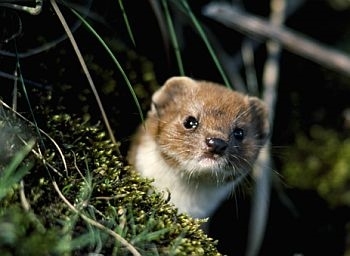
Weasel © Laurie Campbell
The weasel is Britain's smallest native carnivore. It has a long slender body and a short tail that, unlike a stoat's tail, lacks a black tip. It feeds mainly on small rodents, and flourished when the arrival of myxomatosis led to a much reduced rabbit grazing pressure that benefited voles and mice. It also commonly eats birds and their eggs and chicks, including those of gamebirds. The weasel may be culled throughout the year.
Further information:
Mammal Society website weasel page.
Conservation status and legislation
Status:
UK: Native
World: Least Concern (IUCN Red List)
Legislation:
Distribution and abundance
The weasel lives throughout mainland Britain. It is present on the Isle of Sheppey, Isle of Wight, Anglesey and the Scottish islands of Skye and Bute. It is absent from Ireland, the Isle of Man and the Channel Islands.
Estimates of weasel abundance (numbers of individuals in the spring) across the UK, from Harris et al. (1995):
Recent trends from the National Gamebag Census
United Kingdom
Index of bag density from 1961 to 2009 (see statistical methods and interpretational considerations).
Error bars represent 95% confidence intervals.
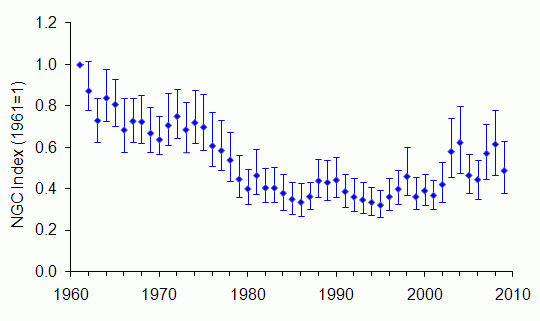
The bag index more than halved between 1961 and the late 1980s/early 1990s. Since then there has been a significant increase, resulting in an overall decline of about a third between 1961 and 2009. The pattern of change is the opposite of that for rabbit, so may be associated with the negative effect of rabbit grazing on vole abundance.
Change in weasel bags over time, with 95% confidence limits (see statistical methods):
| Country |
Sites |
Start
year |
End
year |
Change (%)
1961-2009 |
Change (%)
1984-2009 |
Change (%)
1995-2009 |
| United Kingdom |
1006 |
1961 |
2009 |
-37*
-52 to -22 |
39*
9 to 70 |
51*
23 to 80 |
* significant at P < 0.05
England
Index of bag density from 1961 to 2009 (see statistical methods and interpretational considerations).
Error bars represent 95% confidence intervals.
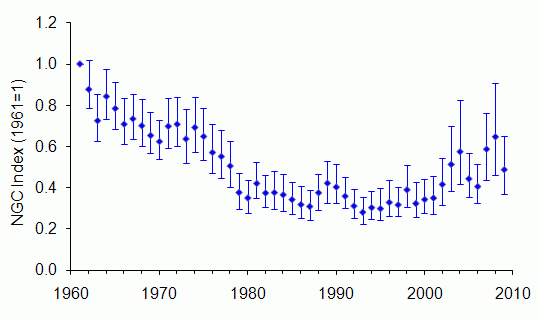
The bag index more than halved between 1961 and the late 1980s/early 1990s. Since then there has been a significant increase, resulting in an overall decline of about a third between 1961 and 2009. The pattern of change is broadly the opposite of that for rabbit, so may be associated with the negative effect of rabbit grazing on vole abundance.
Change in weasel bags over time, with 95% confidence limits (see statistical methods):
| Country |
Sites |
Start
year |
End
year |
Change (%)
1961-2009 |
Change (%)
1984-2009 |
Change (%)
1995-2009 |
| England |
735 |
1961 |
2009 |
-37*
-53 to -19 |
53*
9 to 104 |
73*
31 to 122 |
* significant at P < 0.05
Scotland
Index of bag density from 1961 to 2009 (see statistical methods and interpretational considerations).
Error bars represent 95% confidence intervals.
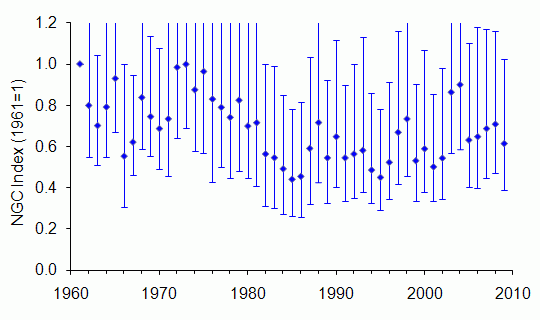
There has been no detectable change in the bag index between 1961 and 2009.
Change in weasel bags over time, with 95% confidence limits (see statistical methods):
| Country |
Sites |
Start
year |
End
year |
Change (%)
1961-2009 |
Change (%)
1984-2009 |
Change (%)
1995-2009 |
| Scotland |
242 |
1961 |
2009 |
-16
-43 to 32 |
17
-17 to 65 |
23
-4 to 55 |
* significant at P < 0.05
Wales
Index of bag density from 1961 to 2009 (see statistical methods and interpretational considerations).
Error bars represent 95% confidence intervals.
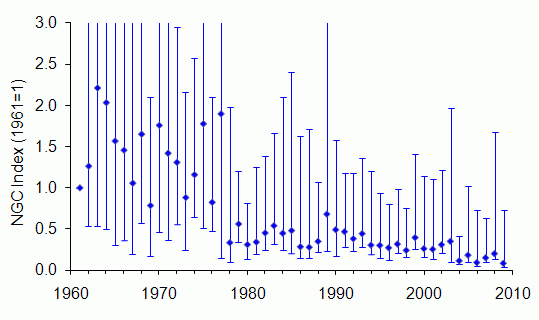
There has been an apparent decline in the bag index between 1961 and 2009, but it is not statistically significant. The apparent pattern is the opposite of that for rabbit, so may be associated with the negative effect of rabbit grazing on vole abundance.
Change in weasel bags over time, with 95% confidence limits (see statistical methods):
| Country |
Sites |
Start
year |
End
year |
Change (%)
1961-2009 |
Change (%)
1984-2009 |
Change (%)
1995-2009 |
| Wales |
28 |
1961 |
2009 |
-93
-96 to 25 |
-75
-88 to 16 |
-67
-85 to 41 |
* significant at P < 0.05
N Ireland
There are too few bag records of weasel to produce an index graph. 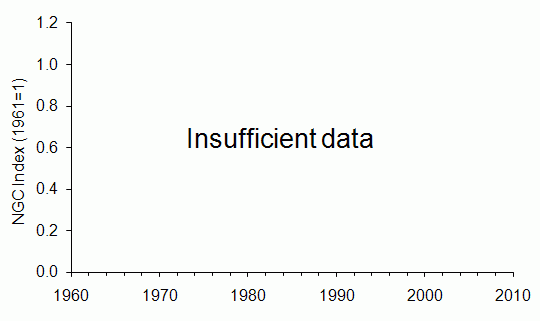
There are too few bag records of weasel to evaluate rates of change over time
| Country |
Sites |
Start
year |
End
year |
Change (%)
1961-2009 |
Change (%)
1984-2009 |
Change (%)
1995-2009 |
| N Ireland |
Too few sites |
Environmental zones
Change in weasel bags over time, with 95% confidence limits (see statistical methods):
| Environmental zone |
Sites |
Start
year |
End
year |
Change (%)
1961-2009 |
Change (%)
1984-2009 |
Change (%)
1995-2009 |
| Easterly lowlands (England/Wales) |
476 |
1961 |
2009 |
-70*
-80 to -59 |
-35*
-55 to -16 |
-18
-41 to 5 |
| Westerly lowlands (England/Wales) |
181 |
1961 |
2009 |
-67*
-81 to -45 |
-32
-58 to 6 |
-6
-40 to 37 |
| Uplands (England/Wales) |
102 |
1961 |
2009 |
16
-58 to 758 |
311*
166 to 537 |
204*
131 to 307 |
| Lowlands (Scotland) |
71 |
1961 |
2009 |
-64*
-86 to -7 |
-47
-72 to 3 |
-38
-67 to 9 |
| Intermediate uplands/islands (Scotland) |
34 |
1961 |
2009 |
-81*
-89 to -50 |
-40
-66 to 71 |
-26
-57 to 57 |
| True uplands (Scotland) |
137 |
1961 |
2009 |
37
-22 to 127 |
53*
3 to 168 |
52*
12 to 109 |
* significant at P < 0.05
Comparison with BBS mammal data
No comparison with the NGC trend is possible because too few weasel records are received through the Breeding Bird Survey (BBS) organised by the British Trust for Ornithology.
Long-term trend from the National Gamebag Census
There are too few bag records of weasel to produce a trend starting before 1961.
References and further reading
- Battersby,J. (2005). UK Mammals: Species Status and Population Trends. Joint Nature Conservation Committee/Tracking Mammals Partnership, Peterborough (JNCC download page).
- Harris,S., Morris,P., Wray,S. & Yalden,D.W. (1995). A Review of British Mammals: Population Estimates and Conservation Status of British Mammals Other than Cetaceans. Joint Nature Conservation Committee, Peterborough (JNCC download page).
- Harris,S. & Yalden,D.W. (2008). Mammals of the British Isles: Handbook, 4th edition. Mammal Society, Southampton.
- McDonald,R. & Harris,S. (2006). Stoats and Weasels. Mammal Society, Southampton.
- Sheffield,S.R. & King,C.M. (1994). Mustela nivalis. Mammalian Species 454: 1-10.
This report should be cited as: Aebischer,N.J., Davey,P.D. & Kingdon,N.G. (2011). National Gamebag Census: Mammal Trends to 2009. Game & Wildlife Conservation Trust, Fordingbridge (http://www.gwct.org.uk/ngcmammals).
Return to species list